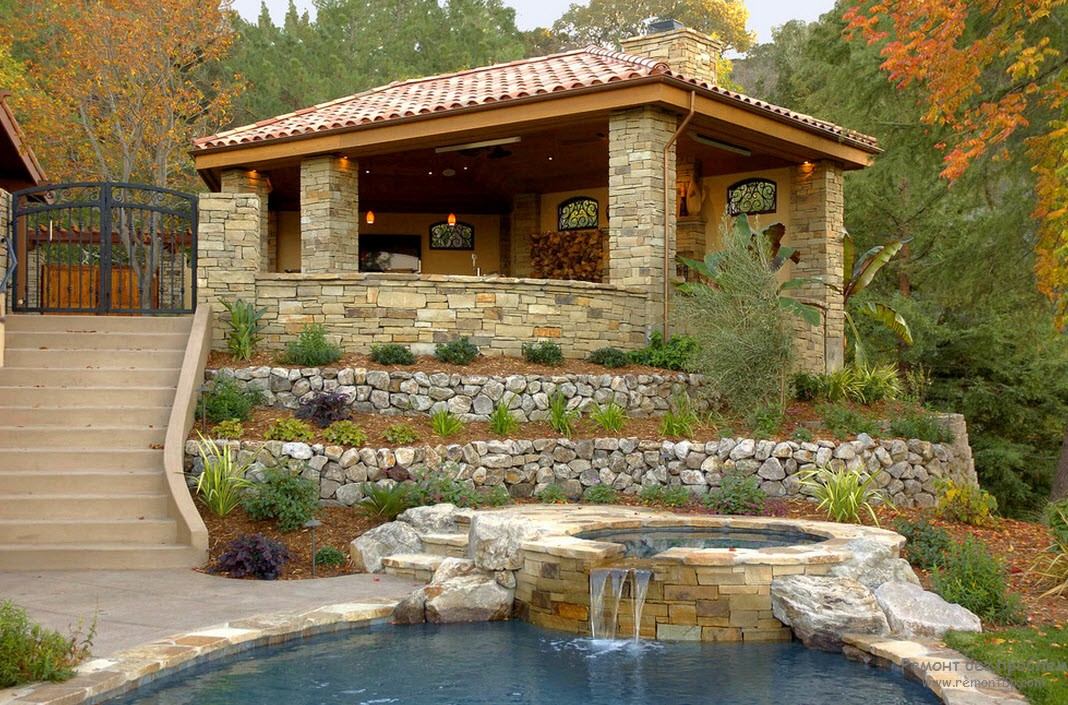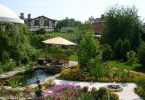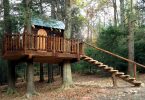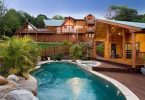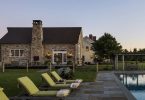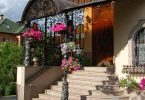The old-timers of country estates have long ago positively decided for themselves the question of whether it is necessary to attach another one – a gazebo to the existing buildings – and thereby make their stay in the fresh air even more attractive and comfortable. They willingly share photos of their gazebos on forums and social networks, give practical advice on construction and arrangement..
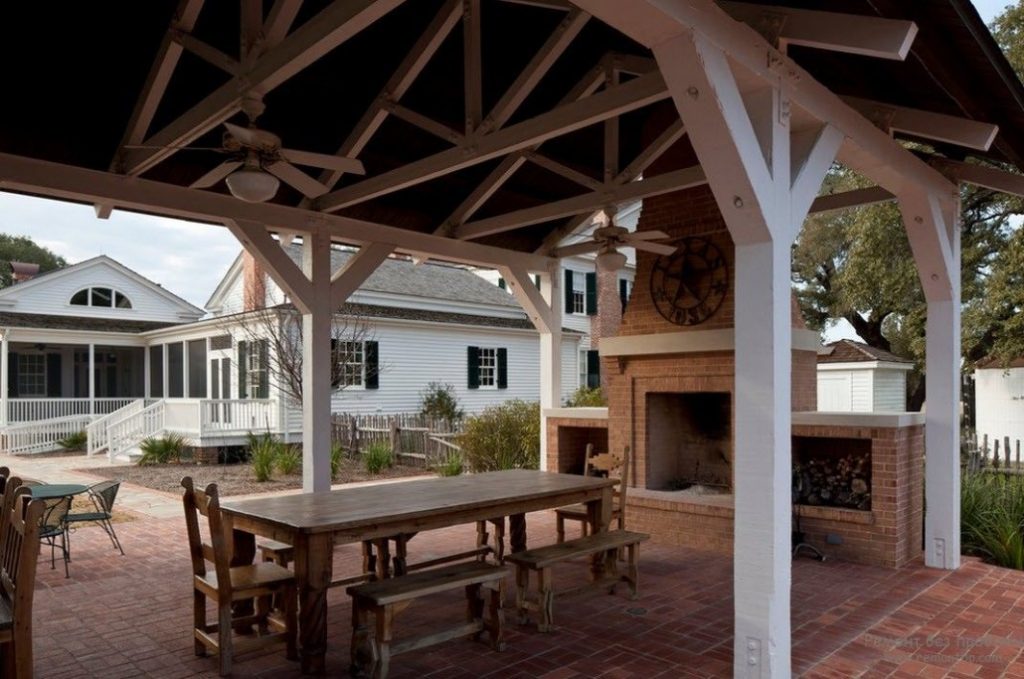
The location next to the residential building is typical for barbecue gazebos

The gazebo, successfully integrated into the surrounding space, seems to be an integral part of the green zone
A lot of factors affect what the gazebo will be according to the time criterion of presence on the site: stationary (barbecue gazebo) and collapsible.
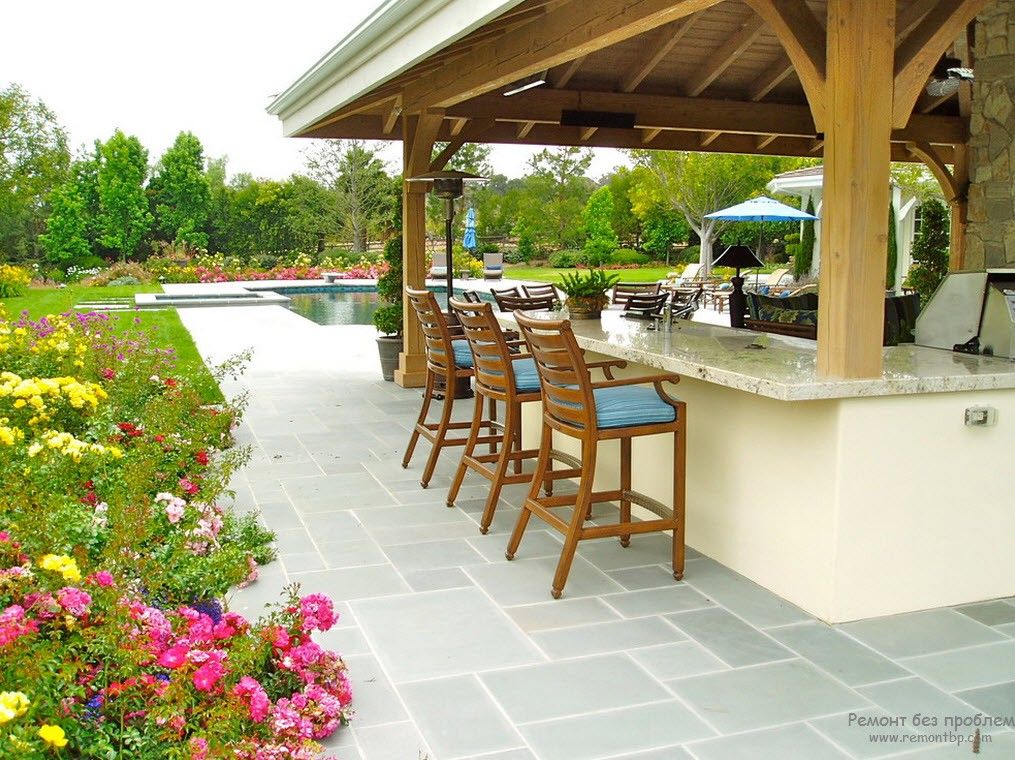
The barbecue gazebo usually occupies a rather large area, as it is designed to receive large companies

A characteristic feature of barbecue gazebos is the division into cooking, dining and relaxation areas
A gazebo is a light architectural structure to create a specific natural and cultural environment. It must match its size and the style of all buildings. Its direct purpose is to protect from rain and heat, serve as a pleasant place for relaxation, romantic meetings, family gatherings, and creative activity in between household chores. But for whatever purpose the construction is started, its success will be determined by how harmoniously the building will fit into the surrounding landscape, whether it will form a compositional unity with a house, a fence, avenues, bridges, benches, a pond and flower beds – all the attributes of a cozy and beautiful landscape design.

Organic combination of composition elements – a gazebo, a fence, alleys, flower beds, shrubs and ampelous plants
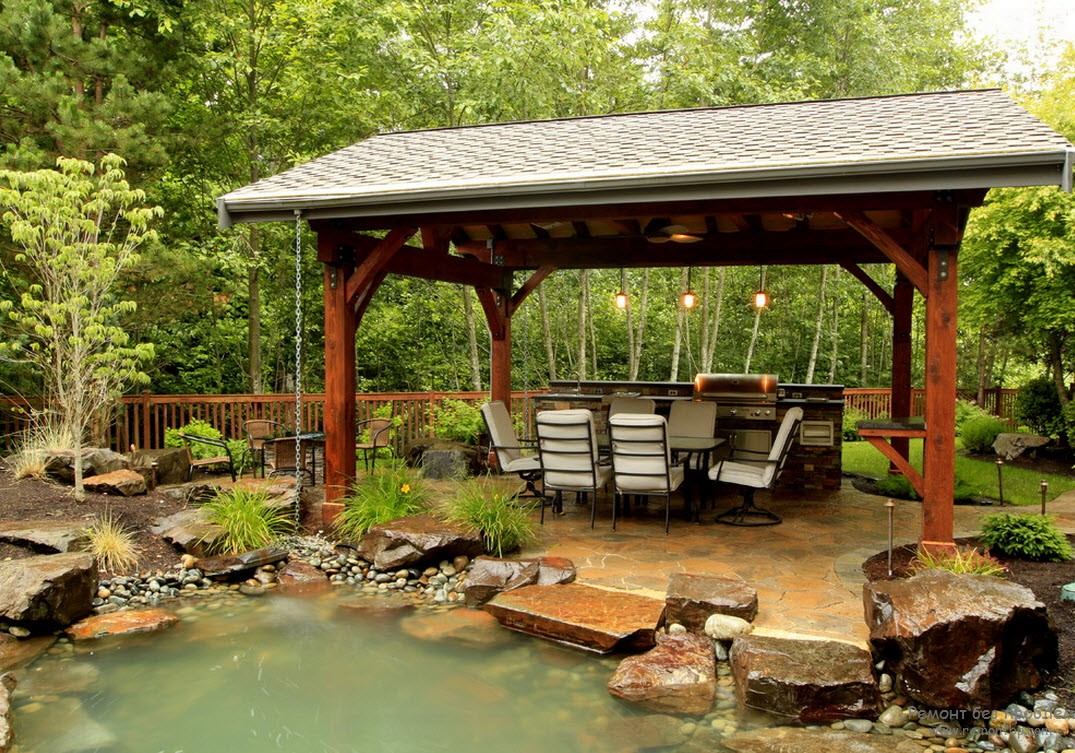
The place of the gazebo next to an artificial reservoir is one of the most successful solutions
Recently, some types of gazebos instead of «light construction» quite applicable definition «monumental». And in this case, we are not talking about a place for contemplation and solitude, but, on the contrary, about the reception of a large company.
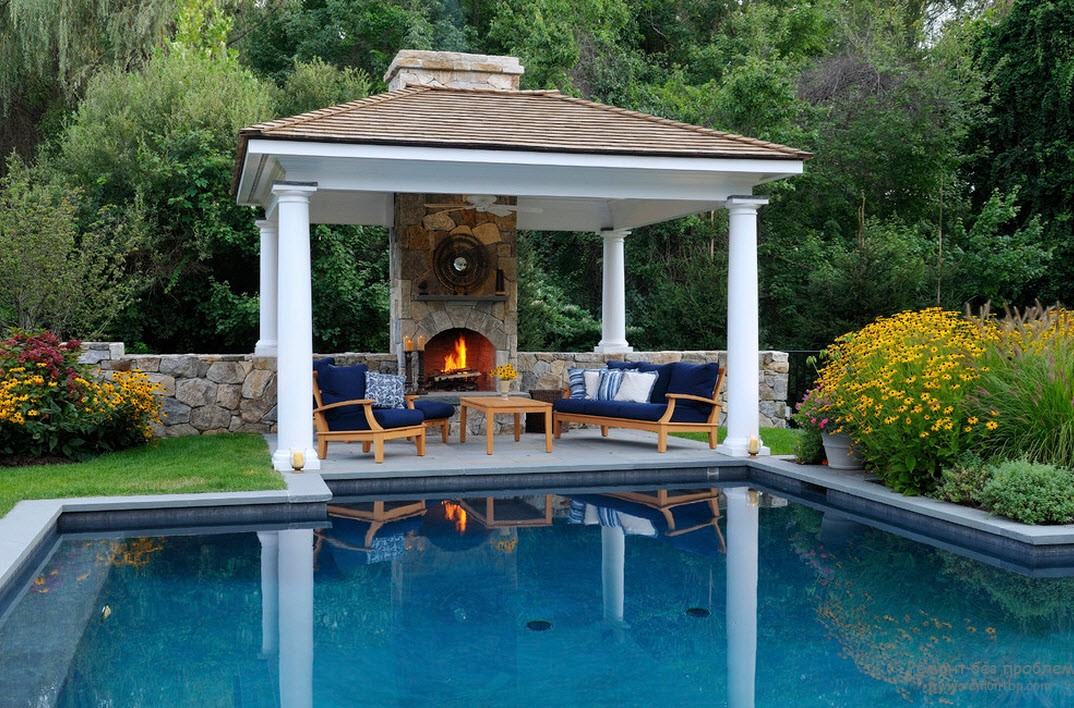
A barbecue gazebo in a classic style is located against the backdrop of decorative trees and flowers, reflected in the water surface of the pool
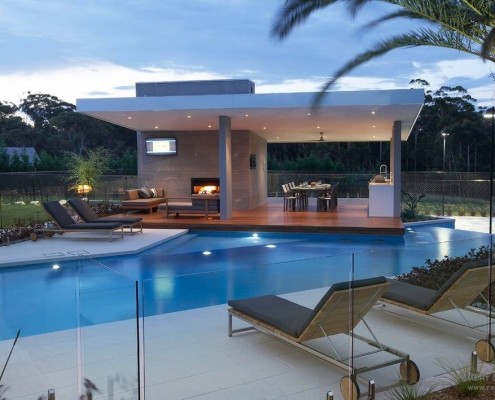
The southern version of the complex of the gazebo-barbecue and the pool looks especially impressive in the evening thanks to the complex illumination system
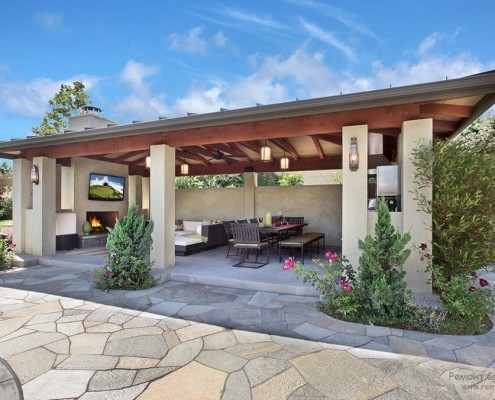
Free space without a large number of plantings has benefited from the placement of a slender stone gazebo in a modern style with a pitched roof, tiled surroundings and laconic landscaping
There are many classifications of gazebo styles that are in one way or another related to artistic trends in architecture and design. One of the generally accepted is to associate the appearance of a structure with its geographical origin:
- Classic (it follows the strict proportions and forms of Antiquity, Renaissance and Classicism)
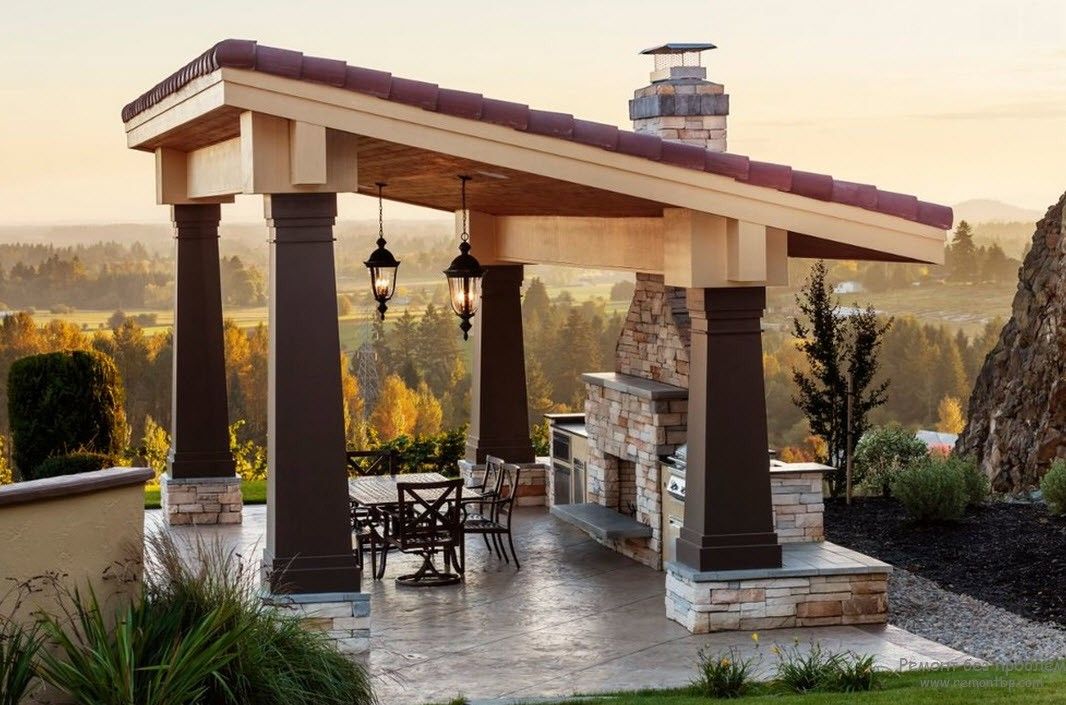
A canopy gazebo, the roof of which rests on massive columns, reminiscent of ancient temples. Located on an elevated part, it allows you to enjoy the amazing panoramic views
- Eastern (Moorish, Egyptian, Persian, Indian, Chinese, Japanese)
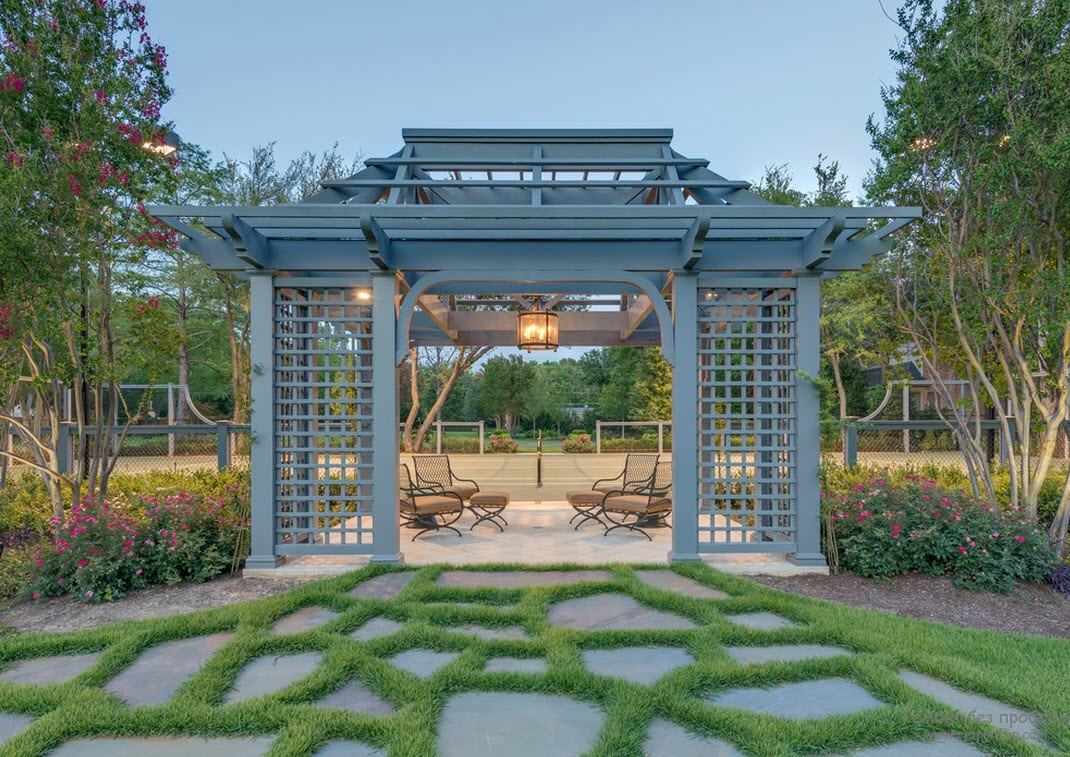
The openwork gazebo resembles a watercolor painting on Chinese silk. Here the choice is ambiguous: either admire the view from the gazebo, or admire the skillful construction from afar
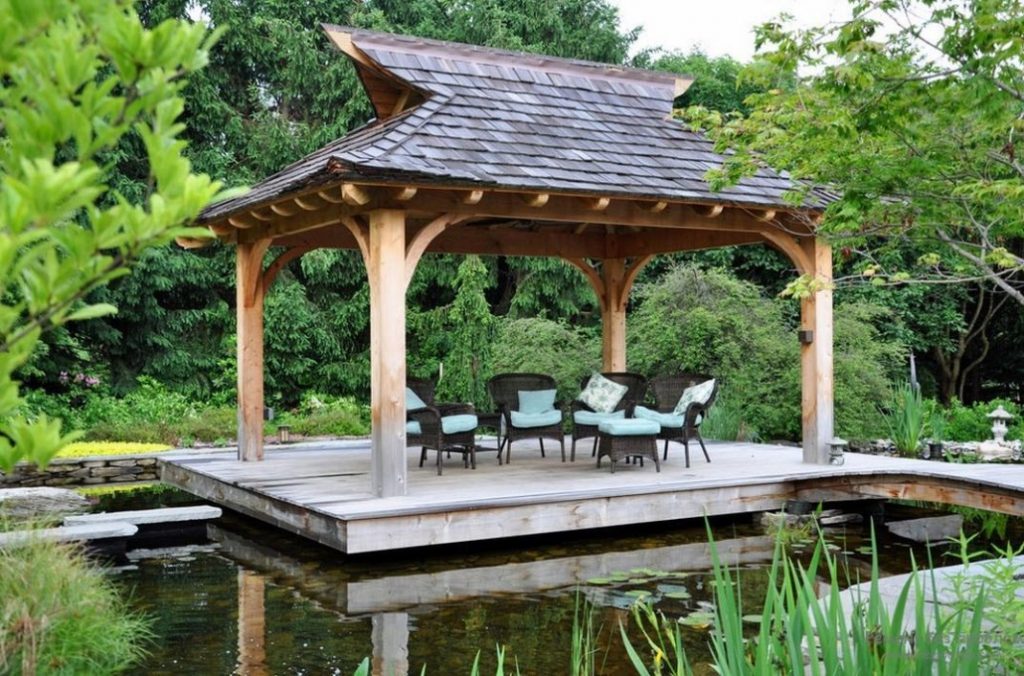
The harmonious union of the elements of wood, wildlife and water is embodied in a Japanese-style gazebo

A tent-shed, spread out by the water, protects well from the sun and allows you to fully enjoy your stay in the fresh air. The light structure is closed from the wind by tall bushes decorated using the topiary technique (decorative haircut). At the end of the warm season, it is dismantled and stored until next year
- English (more commonly referred to as Victorian, trellises and vines)
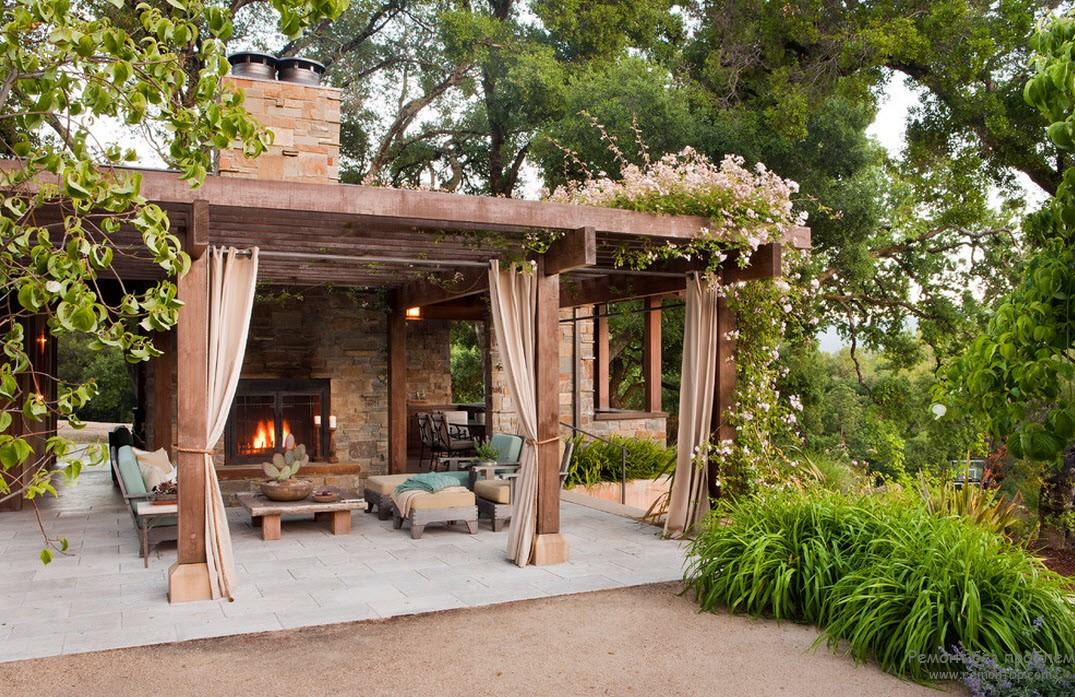
The austere lines of the English style gazebo with a fireplace are softened by beautifully selected flowering vines
- Scandinavian (absolute integration into the surrounding nature, massive stone walls and a large number of wooden parts)
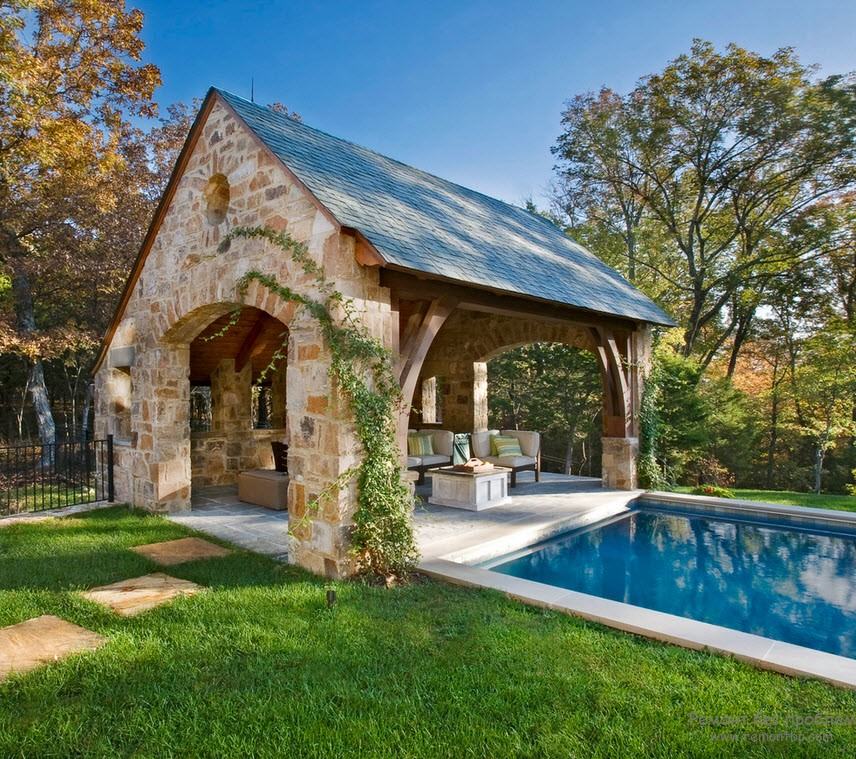
The gazebo, built of large stone blocks, has two wide entrances of a characteristic configuration for a Norman house, a lawn with a stone fragmentary path and a surface of water in which the sky is reflected – bright features of the Scandinavian style
- popular rustic style (with thatched or reed roofs), rustic (rough structures «clumsy» works), Italian (an abundance of gratings, ceramics and flowers – pergola, belvedere), as well as modern style (or fusion, combining styles at the will of the owners’ imagination and taste).
A place on the site has been determined, a photograph has been chosen from the presented collection or the desired image has been embodied by hand on paper. Now is the time to start choosing materials, depending on which one of the following arbor options will be erected: stone, wooden, forged, glass (pavilion) or innovative materials (polycarbonate).
When creating a stone barbecue gazebo, an inclined relief was successfully used,
which made it possible to include a wide staircase in the composition,
plant terraces, well and pond
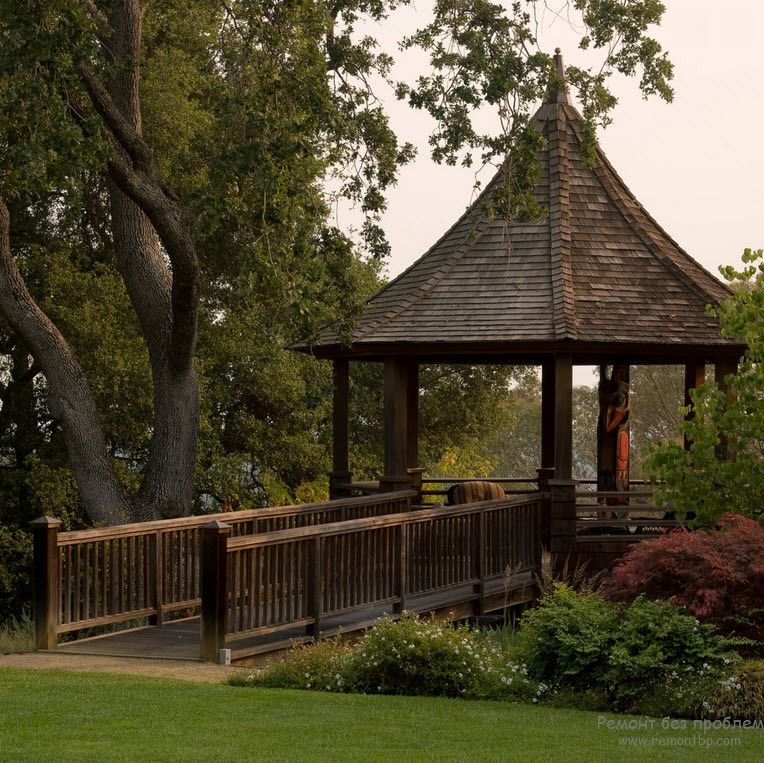
A wooden multifaceted gazebo with a tent-like roof and a bridge leading to it with high railings evokes an association with Pushkin’s lines: «There is a Russian spirit …»
Structurally, gazebos differ in the presence (or absence) of solid walls:
- Open – represent a canopy on supports and are intended for recreation in the warm season.
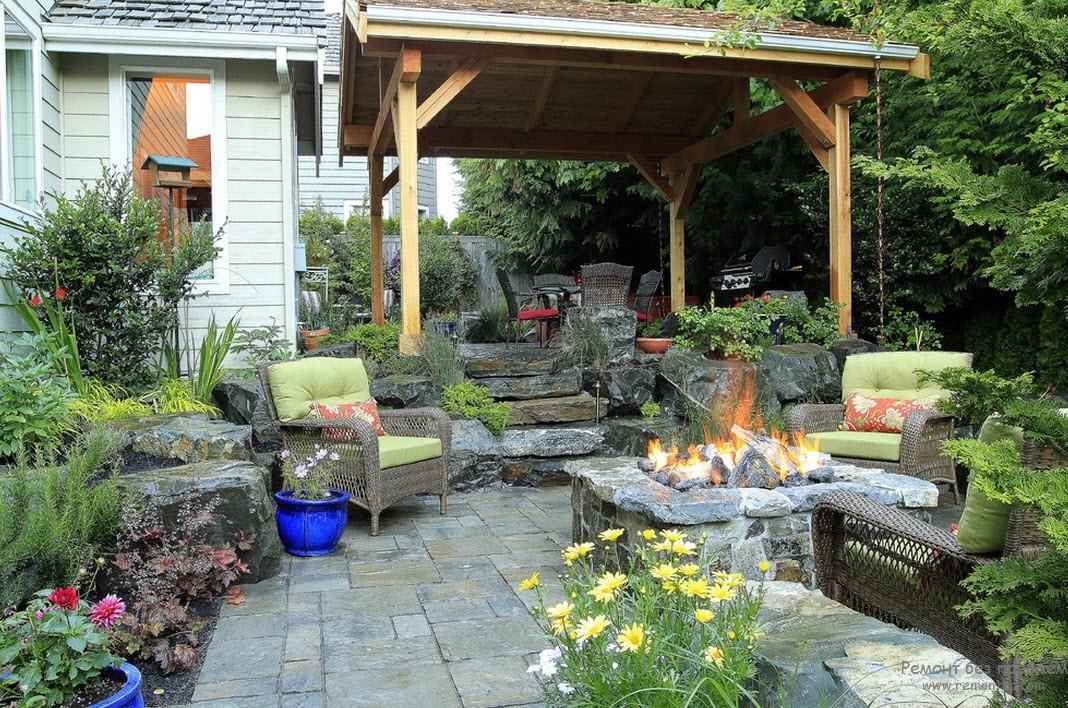
The gazebo-shed is located near the residential building. Seating and cooking areas are clearly demarcated by placement at different levels. Combination of wood and stone
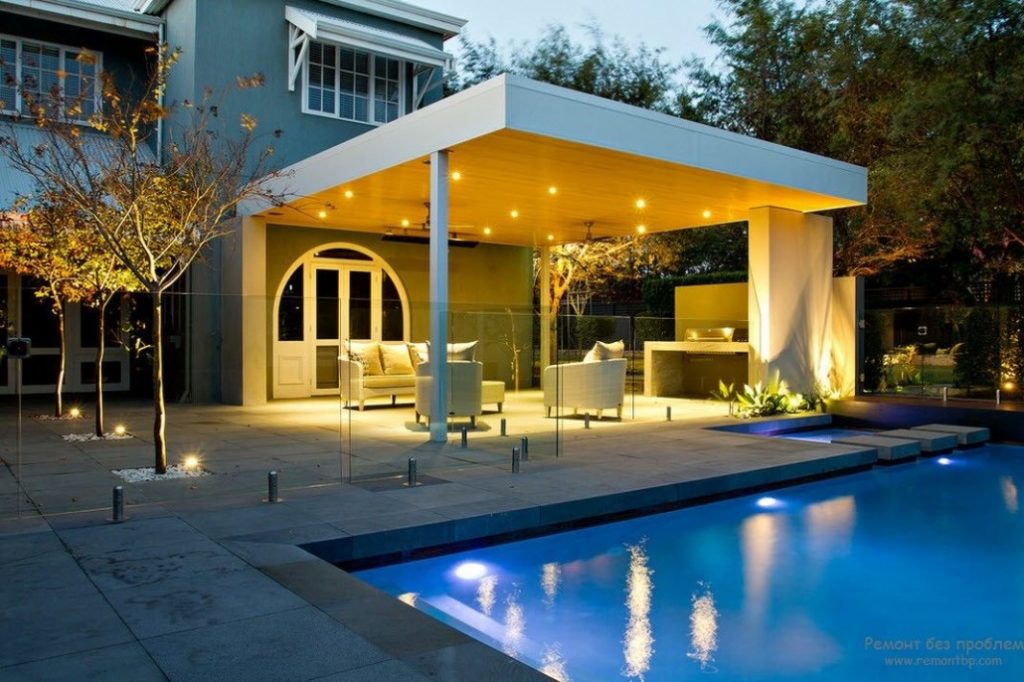
A canopy gazebo adjoins the house directly on one side, and the pool on the other. The bathing area is separated by a transparent fence that does not interfere with the perception of the architectural composition as a whole

The open-type gazebo is supported by wooden columns, which, in turn, are installed on a high foundation that protects the wood from moisture
- Closed – a cross between a gazebo and a summer house, separated from the surrounding space on all sides by walls and a door, you can relax almost throughout the year.
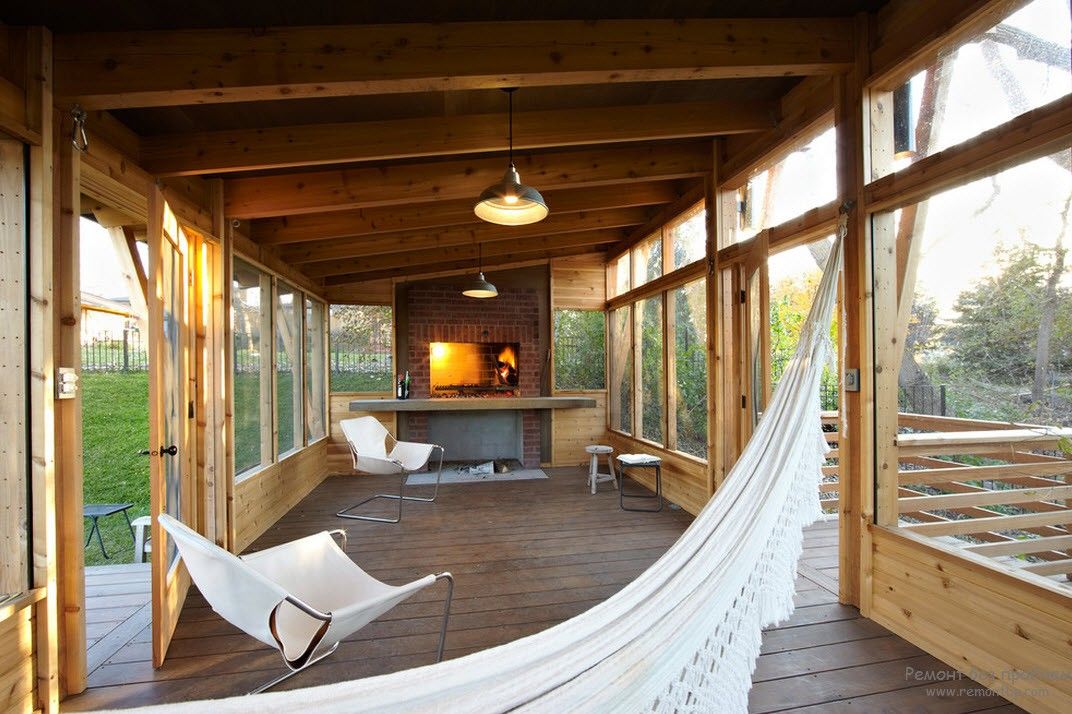
The simple geometric shape of a wooden gazebo with glazed facades is a reliable shelter from wind and rain
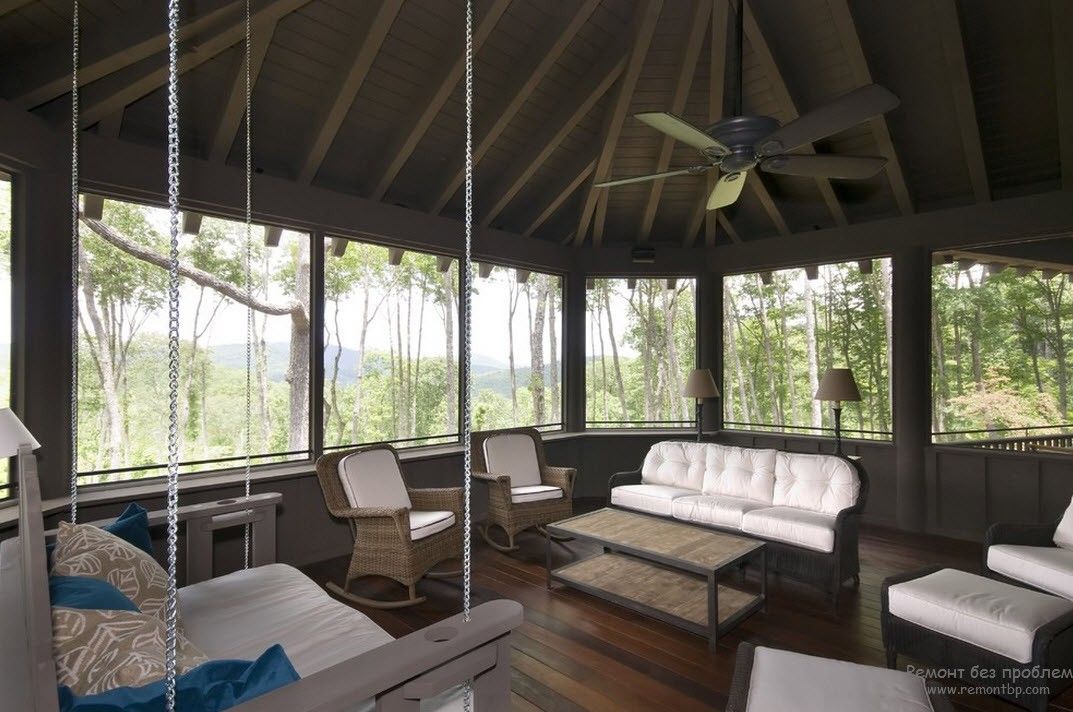
A gazebo of complex configuration with wide glazed windows, which can be completely closed or closed depending on the weather, allow you to spend a long time here
- Semi-closed – surrounded by three closed sides and have an open part of the facade for the entrance. You can stay in them from early spring to late autumn..
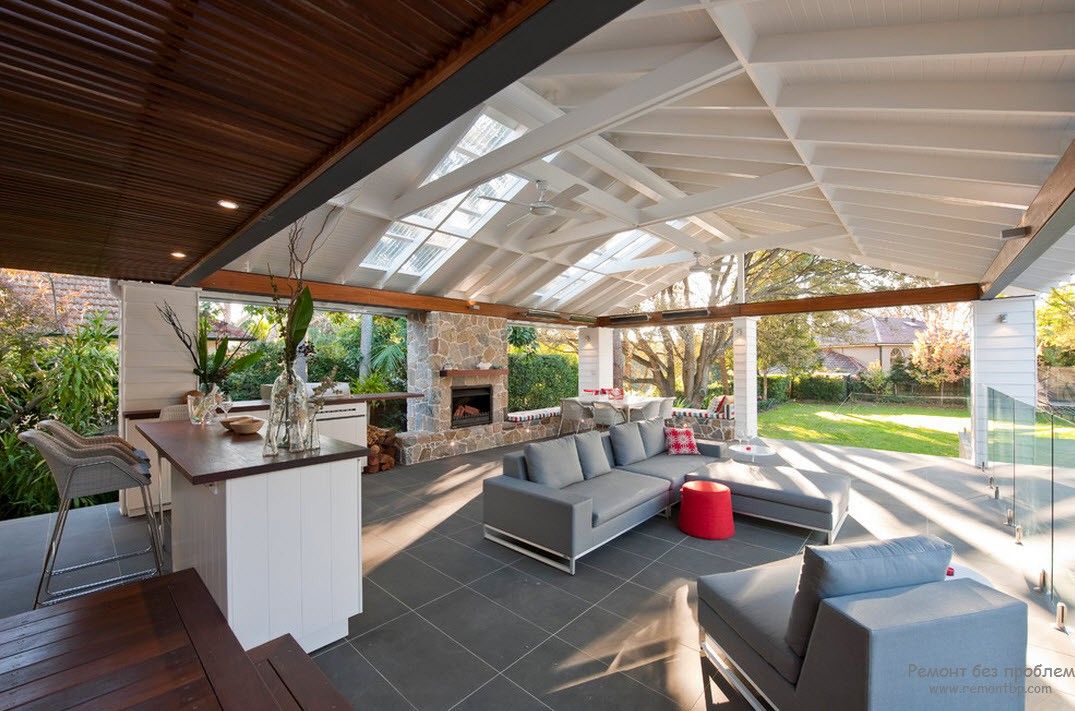
A spacious barbecue gazebo with an island-type kitchen set is more reminiscent of a summer house for permanent residence, but the open part serving as an entrance reminds that in the image there is a gazebo
The gazebo illuminated in the evening looks just great in the photo. But when installing an illumination system, care should be taken to protect yourself from the invasion of uninvited guests – mosquitoes, moths and other insects.
A spacious wooden gazebo for relaxing will protect a large number of invited guests from the rain.
Protection from uninvited – night insects – will serve as curtains made of mesh fabric,
which can simultaneously become an element of stylish drapery

